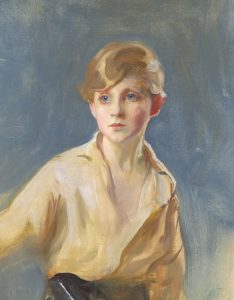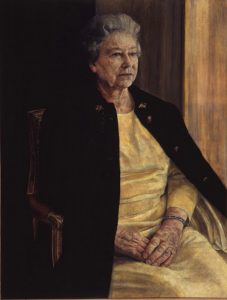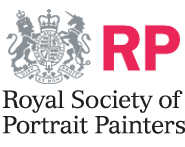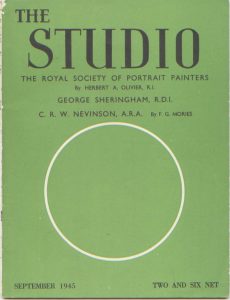Overview of British Portraiture
For 500 years we have been a nation of portrait lovers. We not only gave birth to great face painters – native geniuses like William Dobson, William Hogarth, Sir Joshua Reynolds, Thomas Gainsborough and Sir Thomas Lawrence – but, when needs must, we lured them to our shores.
Masters like Hans Holbein, Sir Anthony van Dyck, Sir Godfrey Kneller, Carl Xavier Winterhalter and John Singer Sargent came to London for the riches and acclaim that a society in thrall to self-representation could bestow upon them.
In more recent years British artists like Stanley Spencer, Lucian Freud and David Hockney have continued to keep the British face in the forefront of world class figurative art.
Today
Today, portrait painting is a thriving art form that has enjoyed a notable revival, evidenced by the multifarious offerings and talents that surface annually at the National Portrait Gallery and Royal Society of Portrait Painters.
The breadth, depth and status of the National Portrait Gallery in London (founded in 1856) has no equal throughout the world, including America. It enriches this art form with establishment approval.
The House of Commons and the House of Lords are continuously commissioning new works for their art collections, as are numerous city guilds, Inns of Court and civic organisations across the country. At any given moment there are hundreds of individuals throughout the nation who are being immortalised in countless contrasting guises and media.
Tudor Origins
In Tudor times, a preoccupation with asserting (recently acquired) authority co-incided with a ban on religious art. As a result, the German genius Hans Holbein was commissioned with expectant gusto as a portraitist. Only a man of his illusionistic powers could transform the calorific bulk that was Henry VIII into an object of imperial strength.
He was little short of a magician. His drawings of the faces of the Tudor court reach the contemporary viewer with a cinematic clarity and conviction, laying the foundations of our portrait culture.
Power Portraits
The big players at the most evocative moments in English history benefited from the services of some outstanding painters. The supremely graceful marriage between the artistic genius of the Flem, Anthony Van Dyck and the spindly frame of Charles I led to images of almost divine power. Later in the century Charles II found in Sir Peter Lely a man who could voyage across the sensuous cheeks and bodies of the court mistress better than he could.
Meritocrats of the Enlightenment were immortalised in multifarious guises by Reynolds, who grafted the gesticulations of Roman antiquity onto pale English bodies.
Although the Victorians lacked the type of élan suited to the swagger brush, George IV’s early 19th century Regency froth was crystallised by Sir Thomas Lawrence.
Afterwards, the Edwardian beau monde was captured by the dazzling, effervescent strokes of John Singer Sargent.
Innovation, chic, directness and theatre mark out all these portraitists: indeed it is tempting to believe that they in part created, rather than merely recorded, the history of British society.
Middle Class Pride
Underpinning the history of British portraiture has been an insatiable need to record status and achievement. The great swell in middle class population from the late 17th century created a merchant and professional class that began commissioning portraits. The mayor, the soldier, the banker, the cleric and the politician – together with their respective wives and sometimes children – all required a brush with immortality.
William Hogarth was the first native born painter of genius who understood the balance between rank and personality. Thomas Gainsborough’s portraits of his Ipswich sitters, Sir Henry Raeburn’s Edinburgh worthies, and the innumerable heads by artists like John Partridge, George Frederick Watts and John Everett Millais follow a path through the 20th century that culminates, amongst other places, at the Royal Society of Portrait Painters.
Portraits for Art’s Sake
Portraiture, or the human face and body, have allowed artists to express their own concerns and interests about the human condition. This is part of a long tradition that in some ways could be said to have begun with the introspection of Rembrandt’s self-portraits. It has taken on exciting and varying directions.
Francis Bacon contorted bodies and visages brilliantly to express his psychic angst. In many ways every Lucian Freud is a self-portrait, so consistent are his compellingly individualistic, often unsettling characterisations.
What is keeping figurative portrait painting artistically alive is the work of genuinely innovative practitioners who infuse what could become a pedestrian art form with personal, reflective and challenging approaches.
© Philip Mould OBE 2009
A History of the Royal Society of Portrait Painters

Detail of Lord Elphinstone by Philip de Laszlo Member of the Royal Society of Portrait Painters
During the last quarter of the 19th century, interest in portrait painting revived. It not only became fashionable to commission portraits as a means of celebrating and honouring those of high rank or achievement, but it was becoming a genre worthy of critical attention.
The Royal Academy, however, remained closed to portraits by those beyond its doors and consequently, a number of young painters banded together, ‘the front rank of Outsiders’ as the Magazine of Art called them, to form their own movement.
1891 A committee comprising Archibald John Stuart-Wortley (chairman), James Jebusa Shannon, George Percy Jacomb-Hood, Arthur Melville, and Hon. John Collier carried a proposal to form a Society of Portrait Painters. Wortley was its first President and its first exhibition was deemed a critical success.
The catalogue of the exhibition shows that its committee then consisted of Archibald Stuart-Wortley (Chairman), Hon. John Collier, Arthur Hacker, G. P. Jacomb-Hood, S.J. Solomon, James Jebusa Shannon, and Hubert Vos. The other members listed were Percy Bigland, C. A. Furse, Glazebrook, John McLure Hamilton, Heywood Hardy, Hubert von Herkomer, Henry J. Hudson, Louise Jopling, T. B. Kennington, W. Llewellyn, W. M. Loudan, Arthur Melville, Anna Lea Merritt, F. M. Skipworth, Mrs. Annie Swynnerton, W. R. Symonds, Mary Waller, Edwin A. Ward, Leslie Ward (better known as “Spy”), and T. Blake Wirgman.
1892 The second exhibition was considered to surpass the first with works by John Everett Millais, Frederick Leighton, and members of the Glasgow School, John Lavery, and James Guthrie.
G F Watts, Alma Tadema, and James McNeill Whistler were made members.
1893 John Singer Sargent was established at the forefront of their rank. An annual exhibition launched in the newly opened Grafton Galleries in New Bond St.
1902 The Athenaeum magazine wrote ‘the mere fact that Mr. Watts contributes some of the work of his prime, raises the exhibition above the ordinary level of contemporary shows’
1911 In its 21st year the society gained Royal patronage from King George V, becoming the Royal Society of Portrait Painters (RP). A new wave of painters joined including William Orpen, who broke with past conventions and sought new forms of expression.
1917 The Society put on an exhibition at the Walker Gallery in Liverpool to raise funds for the war effort.
1920 The Grafton Gallery lease expired and the RP moved between the Royal Academy and the R.B.A Galleries for some years before finding a permanent home at The Royal Institute Galleries in Piccadilly, until these were bombed in 1940.
1923 The President and founding member, J.J. Shannon died and was replaced by William Orpen, a President remembered for his magnanimity in instantly writing a cheque to settle the Society’s debts. Orpen was replaced on his death by Lavery, in 1931. During the years that followed such luminaries as Laura Knight, Augustus John, Alfred Munnings among others became members and exhibited with the Society, innovating and propelling it in new directions.

H M The Queen by Antony Williams RP. Winner of the Ondaatje Prize for Portraiture, Royal Society of Portrait Painters 1995
1941 The Society announced a permanent Gallery at 6 ½, Suffolk St, Pall Mall East, London SW1, where the painters’ work could be seen at any time of year
1961 The RP became a founder member of the Federation of British Artists (FBA)
1971 The FBA moves to the Mall Galleries in London
1984 It was announced by the society ‘The President and members have the honour to announce that Her Majesty the Queen has been graciously pleased to grant Her Patronage to the Royal Society of Portrait Painters.’
1986-7 The RP was incorporated as a private limited company and also became a Registered Charity, overseen by John Walton RP.


